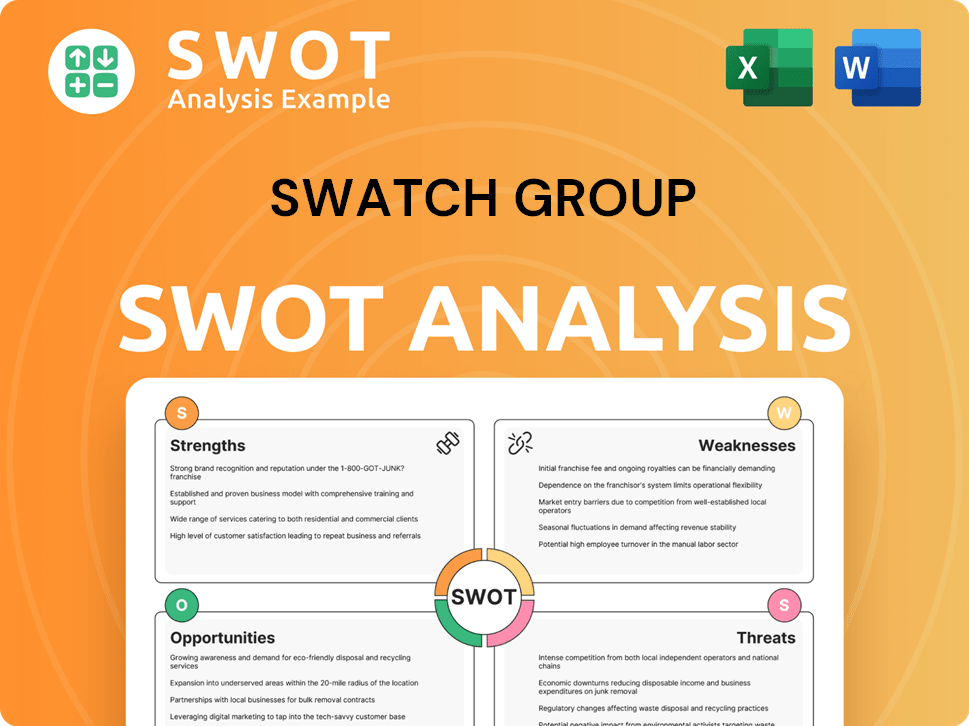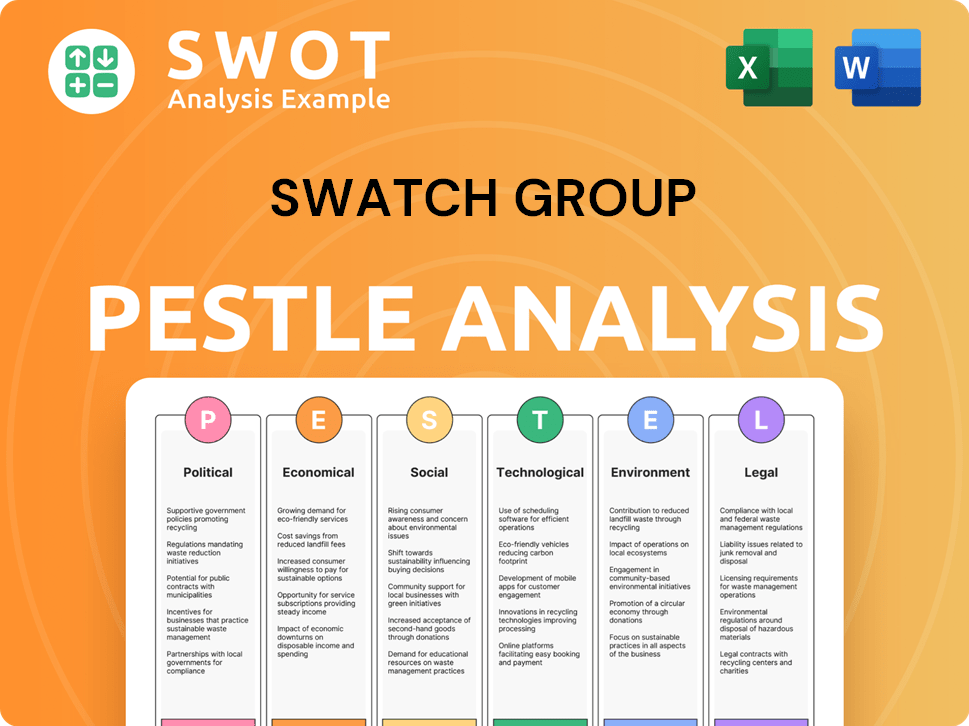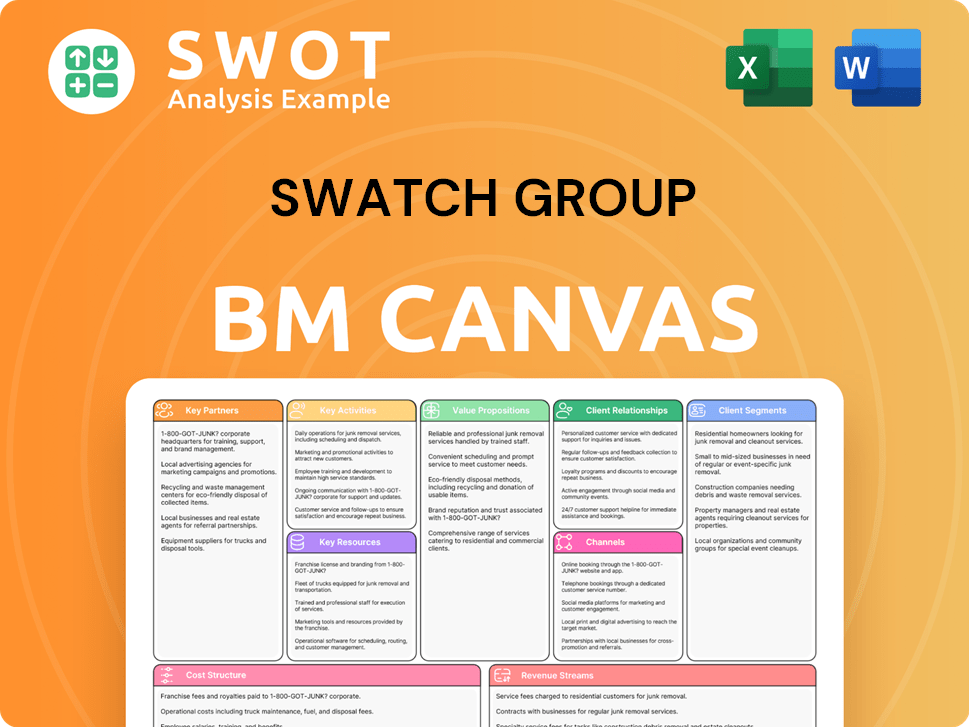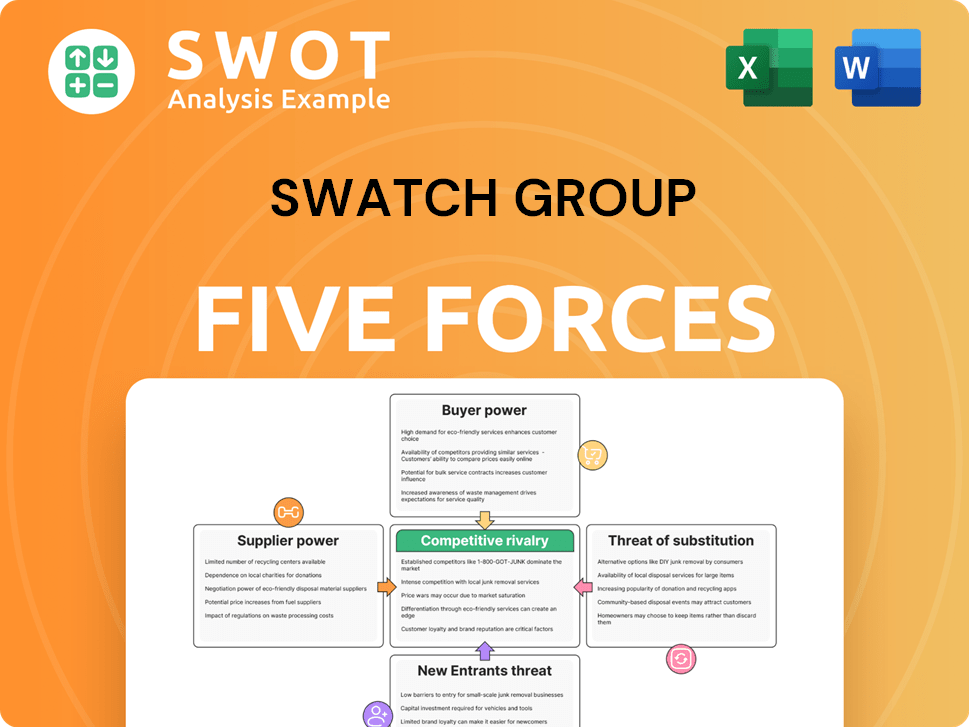Swatch Group Bundle
How Does The Swatch Group Dominate the Watch Market?
The Swatch Group, a titan in the global watch and jewelry industry, employs a sophisticated sales and marketing strategy to maintain its leading position. From accessible Swatch watches to prestigious luxury brands, the group's approach is a masterclass in brand management and market penetration. A key example of their innovative strategy is the MoonSwatch collaboration, which brilliantly blended luxury and accessibility.

This deep dive will explore the Swatch Group SWOT Analysis, examining how this multinational holding company leverages its diverse portfolio of brands to capture market share. We'll analyze the Swatch Group sales strategy, including its distribution channels and retail presence, alongside its dynamic marketing campaigns and digital marketing approach. Understanding the Swatch Group business model is crucial for investors and business strategists seeking to navigate the complexities of the luxury watch market and the Swiss watch industry.
How Does Swatch Group Reach Its Customers?
The Swatch Group employs a multifaceted sales strategy, blending both online and offline channels to reach a diverse customer base. This approach is a key component of their overall Revenue Streams & Business Model of Swatch Group, ensuring broad market penetration and brand visibility. Their strategy focuses on physical retail, e-commerce, wholesale distribution, and strategic partnerships.
Physical retail remains a cornerstone of the Swatch Group's strategy, with boutiques strategically located worldwide. Each brand within the group, such as Omega, Longines, Tissot, and the namesake Swatch, designs its boutiques to reflect its unique identity, enhancing the customer's shopping experience. The Swatch brand, in particular, has leveraged its in-store presence, with collaborations like the MoonSwatch intentionally sold only in-store to increase foot traffic.
The company has also significantly focused on e-commerce platforms through its brand websites, catering to the growing trend of digital shopping. This digital adoption is a key component of their retail and digital expansion strategy for 2025. Wholesale distribution also plays a role, though the group's own retail business achieved stable sales in Europe in 2024, while wholesale sales in Europe saw a reduction of over 10% due to geopolitical conflicts and retailers' fear of excessive stock levels.
The Swatch Group's extensive network of physical retail locations is a primary sales channel. Boutiques are strategically located worldwide, with each brand having its unique store design. In the first half of 2024, retail activities accounted for over 45% of total sales in the Watches & Jewelry segment.
The company has significantly focused on e-commerce platforms through its brand websites, catering to the growing trend of digital shopping. This digital adoption is a key component of their retail and digital expansion strategy for 2025. The emphasis on enhancing direct-to-consumer strategies and online retail presence is a clear strategic focus.
Wholesale distribution is another key channel, though the group's own retail business achieved stable sales in Europe in 2024, while wholesale sales in Europe saw a reduction of over 10% due to geopolitical conflicts. Approved representative retail dealers are used in regions without distribution subsidiaries. Key partnerships and exclusive distribution deals contribute to growth, particularly in markets like the USA, Japan, India, and the Middle East.
The Swatch Group leverages strategic partnerships to expand its market reach. For example, the Rivoli Group achieved considerable sales growth, and a new distribution company in Saudi Arabia performed well in 2024. These partnerships are crucial for growth, especially in key markets like the USA, Japan, India, and the Middle East.
The Swatch Group's sales strategy is a dynamic mix of physical retail, e-commerce, and wholesale distribution, all designed to strengthen direct-to-consumer engagement. The company increased investments in its own retail businesses in 2024, indicating a commitment to this strategy. The focus on digital expansion and strategic partnerships is evident in their 2025 plans.
- Retail Focus: Over 45% of sales from retail activities in the Watches & Jewelry segment in the first half of 2024.
- Digital Expansion: Strong emphasis on e-commerce platforms and direct-to-consumer strategies for 2025.
- Strategic Partnerships: Successful collaborations and distribution deals in key markets, such as the USA, Japan, India, and the Middle East.
- Market Performance: Record sales and market share gains reported in 2024 in several regions.
Swatch Group SWOT Analysis
- Complete SWOT Breakdown
- Fully Customizable
- Editable in Excel & Word
- Professional Formatting
- Investor-Ready Format

What Marketing Tactics Does Swatch Group Use?
The Swatch Group employs a multifaceted marketing strategy to enhance brand awareness, generate leads, and drive sales across its diverse portfolio of watch and jewelry brands. This strategy encompasses a blend of digital and traditional media, with a significant focus on experiential marketing and strategic collaborations. The company's approach also includes data-driven marketing, customer segmentation, and personalization to cater to a broad spectrum of customers, from affordable to high-end luxury timepieces.
Digital marketing plays a crucial role in the Swatch Group's strategy, with active engagement on social media platforms and targeted online advertising. Traditional media, such as television, radio, and print advertisements, also remain part of the marketing mix. The company's marketing investments in 2024, particularly around events like the Olympic Games in Paris, reflect its commitment to maintaining a strong global presence.
A key element of the Swatch Group's marketing tactics is its emphasis on collaborations and experiential marketing. These initiatives are designed to connect with consumers on a deeper level, reinforce brand identity, and foster a sense of community. The company's commitment to innovation, as evidenced by its patent applications, suggests a sophisticated approach to various aspects of its business, including marketing analytics.
The Swatch Group leverages content marketing, social media, and online advertising to build brand awareness and engage with consumers. Digital expansion and enhancing online retail presence are key strategic focuses for 2025.
Traditional media, including television, radio, and print advertisements, continue to be part of the marketing mix. Sponsorships, such as being the official timekeeper of the Olympics, provide significant exposure.
The company utilizes data-driven marketing, customer segmentation, and personalization to tailor product offerings and messaging. This approach is evident in its tiered pricing strategy.
The Swatch Group emphasizes collaborations and experiential marketing to connect with consumers. The MoonSwatch collaboration and partnerships with cultural institutions, like the Biennale Arte 2024, are examples of this strategy.
The Swatch Group's brand positioning strategy caters to a broad spectrum of customers, from affordable Swatch watches to high-end luxury timepieces. This is a key aspect of the Growth Strategy of Swatch Group.
The company's commitment to innovation is reflected in its patent applications, with 196 new applications in 2024. This suggests a sophisticated approach to marketing and other business aspects.
The Swatch Group's marketing strategy is designed to enhance brand awareness and drive sales. The company uses a mix of digital and traditional media, with a strong emphasis on experiential marketing and strategic collaborations. The company's approach includes data-driven marketing, customer segmentation, and personalization to cater to a broad spectrum of customers.
- Digital Marketing: Active on social media, content marketing, and online advertising.
- Traditional Media: Utilizes television, radio, and print advertising.
- Experiential Marketing: Engages in collaborations and cultural partnerships.
- Data-Driven Approach: Employs customer segmentation and personalization.
- Brand Positioning: Caters to a wide range of price points and customer segments.
Swatch Group PESTLE Analysis
- Covers All 6 PESTLE Categories
- No Research Needed – Save Hours of Work
- Built by Experts, Trusted by Consultants
- Instant Download, Ready to Use
- 100% Editable, Fully Customizable

How Is Swatch Group Positioned in the Market?
The Swatch Group's brand positioning is a multifaceted strategy designed to cater to a diverse range of consumers. This approach allows the group to compete effectively across various segments of the watch market, from affordable fashion watches to high-end luxury timepieces. The overarching goal is to leverage the group's Swiss heritage, emphasizing precision, innovation, and quality, solidifying its position as a leading watchmaking group globally.
Each brand within the Swatch Group's portfolio, including Omega, Longines, and Swatch, maintains a distinct identity. This differentiation is crucial for attracting specific customer segments. For instance, Omega is positioned as a luxury brand, while Swatch focuses on affordability and trendiness, allowing the group to capture a broad market share. This tiered approach reflects the value offered, from innovative features to luxurious heritage.
The Swatch Group's Swatch Group sales strategy is built on a foundation of brand consistency and adaptability. The group’s ability to navigate market fluctuations and consumer preferences is evident in its strategic adjustments in response to challenges in specific regions, such as China, and its successes in growing markets like the USA, Japan, and India. This agility is key to maintaining its competitive edge in the dynamic Swiss watch industry.
The Swatch Group manages a wide array of brands, each with a distinct identity. This allows them to target different market segments effectively. This includes luxury brands like Omega and more accessible brands like Swatch.
Each brand has a specific core message and visual identity to resonate with its target audience. For example, Omega emphasizes prestige, while Swatch focuses on fashion and affordability. This targeted approach enhances the Swatch Group marketing strategy.
Luxury brands emphasize craftsmanship and heritage, while mid-range brands focus on quality and price. Swatch continues to appeal through modern designs and accessible price points. The USP is the core of the Swatch Group business model.
The Swatch Group is increasingly focused on sustainability, which is becoming a key factor in consumer decisions. Their efforts include reducing energy consumption and using sustainable materials. This is a part of their Swatch Group brands strategy.
The Swatch Group has demonstrated an ability to adapt to changing market conditions. Despite challenges in China in 2024, they achieved record sales in the USA, Japan, India, and the Middle East. This adaptability is key to their success.
The group is targeting growth markets like India, the Middle East, and Japan to diversify beyond China. This strategic move aims to reduce reliance on any single market and capitalize on emerging opportunities. This is part of their Swatch Group's digital marketing approach.
Consistent branding across all channels is maintained through carefully designed boutiques and consistent marketing messages. This ensures a cohesive brand experience for customers. This is a part of Swatch Group's brand positioning strategy.
The strategy includes strengthening mid-range and accessible luxury brands to cater to a broader audience. This approach allows the Swatch Group to capture a larger segment of the market. This is a part of Swatch Group's pricing strategy for luxury watches.
The Swatch Group is committed to sustainability, which includes efforts to reduce energy consumption and use sustainable materials. This commitment is becoming increasingly important to consumers. This is a part of Swatch Group's sustainability initiatives marketing.
In 2024, the Swatch Group saw mixed results, with declines in some regions but gains in others. The USA, Japan, India, and the Middle East showed strong growth. The group's ability to adapt is clear from the sales data. For more information, explore the Owners & Shareholders of Swatch Group.
Swatch Group Business Model Canvas
- Complete 9-Block Business Model Canvas
- Effortlessly Communicate Your Business Strategy
- Investor-Ready BMC Format
- 100% Editable and Customizable
- Clear and Structured Layout

What Are Swatch Group’s Most Notable Campaigns?
The Swatch Group's sales and marketing strategies are characterized by impactful campaigns, strategic collaborations, and a focus on enhancing brand visibility and market reach. These initiatives are designed to resonate with diverse consumer segments, from those seeking accessible fashion watches to individuals interested in luxury timepieces. The group leverages both traditional and digital channels to create buzz, drive sales, and strengthen its position in the competitive Swiss watch industry.
A key element of the Swatch Group's success is its ability to innovate and adapt to changing market dynamics. This is evident in its collaborations, event sponsorships, and product launches. The company's approach involves a mix of exclusivity, mass appeal, and cultural relevance, allowing it to capture attention and maintain a strong presence in the luxury watch market. The following campaigns highlight Swatch Group's effective strategies.
Recent campaigns have significantly influenced the Swatch Group's performance. The company's approach integrates innovative product design, strategic partnerships, and effective marketing channels. These campaigns are designed to boost sales, enhance brand recognition, and engage with a wide audience.
The MoonSwatch collaboration between Swatch and Omega, launched in 2022, aimed to create hype and bridge the gap between luxury and accessible watch segments. The campaign reimagined the iconic Omega Speedmaster Moonwatch design using Swatch's BioCeramic material and vibrant colors. This initiative successfully introduced Omega's heritage to a new audience and significantly boosted Swatch's visibility and sales.
In 2024, the Swatch x Blancpain Fifty Fathoms collection added a sixth product, 'Ocean of Storms - New Moon,' in January 2024. The demand for the 'Scuba Fifty Fathoms Swatch' remained very high throughout 2024. This collaboration highlights the group's ability to create demand and leverage exclusive product launches.
The ongoing partnership with the Olympic Games, through the Omega brand, reinforces the brand's precision and reliability. As the official timekeeper, Omega gains global media presence and brand visibility. This long-standing partnership consistently boosts Omega's brand credibility and global recognition within the Growth Strategy of Swatch Group.
Swatch partnered with the Biennale Arte 2024 in Venice as its main partner, showcasing artwork and collaborating with Japanese graphic artist VERDY. The Swatch x Tate collaboration, launched in Spring 2024, involved a product range inspired by Tate's collection. These cultural collaborations connect Swatch with the art world, reinforcing its creative brand identity.
Swatch Group Porter's Five Forces Analysis
- Covers All 5 Competitive Forces in Detail
- Structured for Consultants, Students, and Founders
- 100% Editable in Microsoft Word & Excel
- Instant Digital Download – Use Immediately
- Compatible with Mac & PC – Fully Unlocked

Related Blogs
- What are Mission Vision & Core Values of Swatch Group Company?
- What is Competitive Landscape of Swatch Group Company?
- What is Growth Strategy and Future Prospects of Swatch Group Company?
- How Does Swatch Group Company Work?
- What is Brief History of Swatch Group Company?
- Who Owns Swatch Group Company?
- What is Customer Demographics and Target Market of Swatch Group Company?
Disclaimer
All information, articles, and product details provided on this website are for general informational and educational purposes only. We do not claim any ownership over, nor do we intend to infringe upon, any trademarks, copyrights, logos, brand names, or other intellectual property mentioned or depicted on this site. Such intellectual property remains the property of its respective owners, and any references here are made solely for identification or informational purposes, without implying any affiliation, endorsement, or partnership.
We make no representations or warranties, express or implied, regarding the accuracy, completeness, or suitability of any content or products presented. Nothing on this website should be construed as legal, tax, investment, financial, medical, or other professional advice. In addition, no part of this site—including articles or product references—constitutes a solicitation, recommendation, endorsement, advertisement, or offer to buy or sell any securities, franchises, or other financial instruments, particularly in jurisdictions where such activity would be unlawful.
All content is of a general nature and may not address the specific circumstances of any individual or entity. It is not a substitute for professional advice or services. Any actions you take based on the information provided here are strictly at your own risk. You accept full responsibility for any decisions or outcomes arising from your use of this website and agree to release us from any liability in connection with your use of, or reliance upon, the content or products found herein.